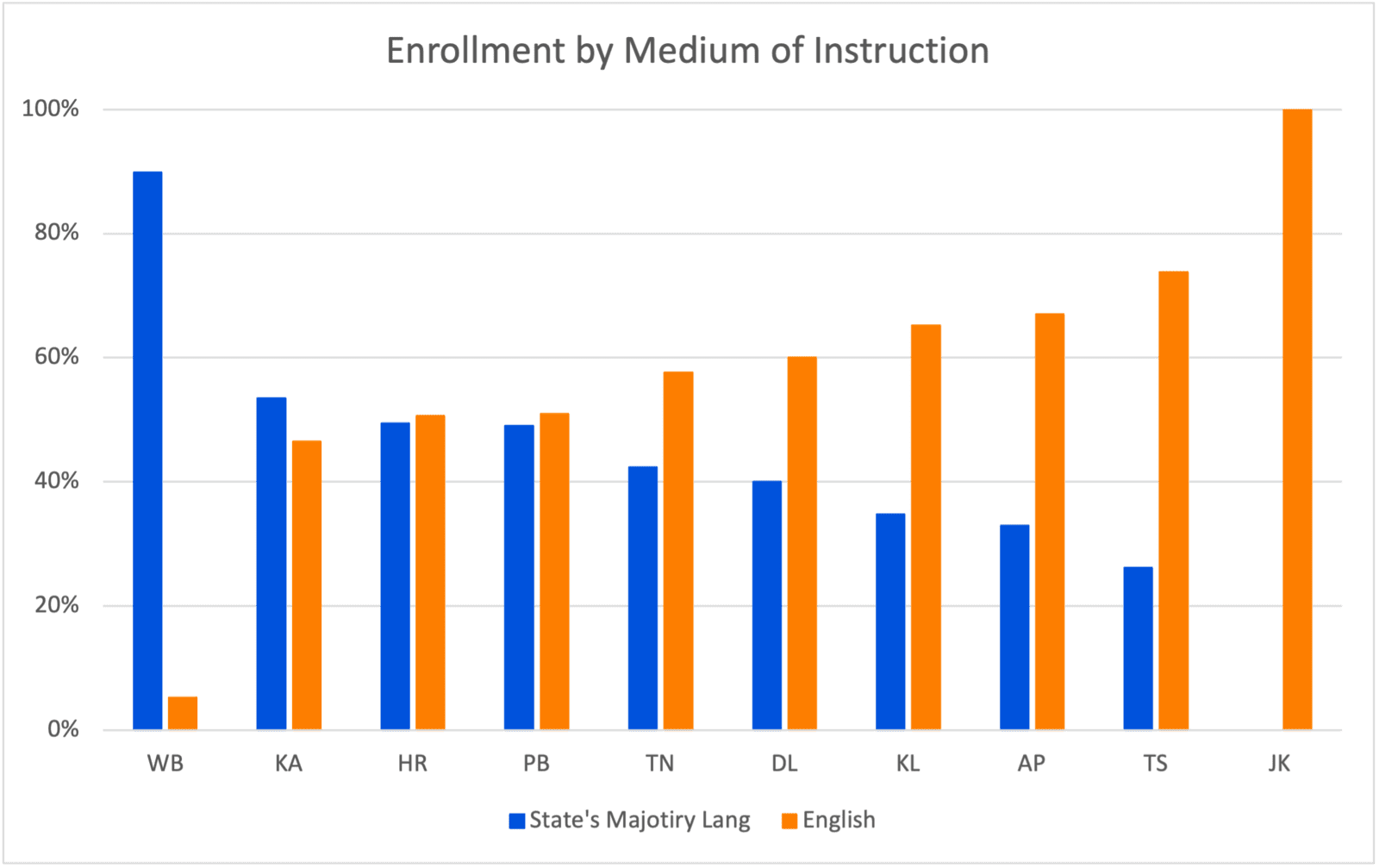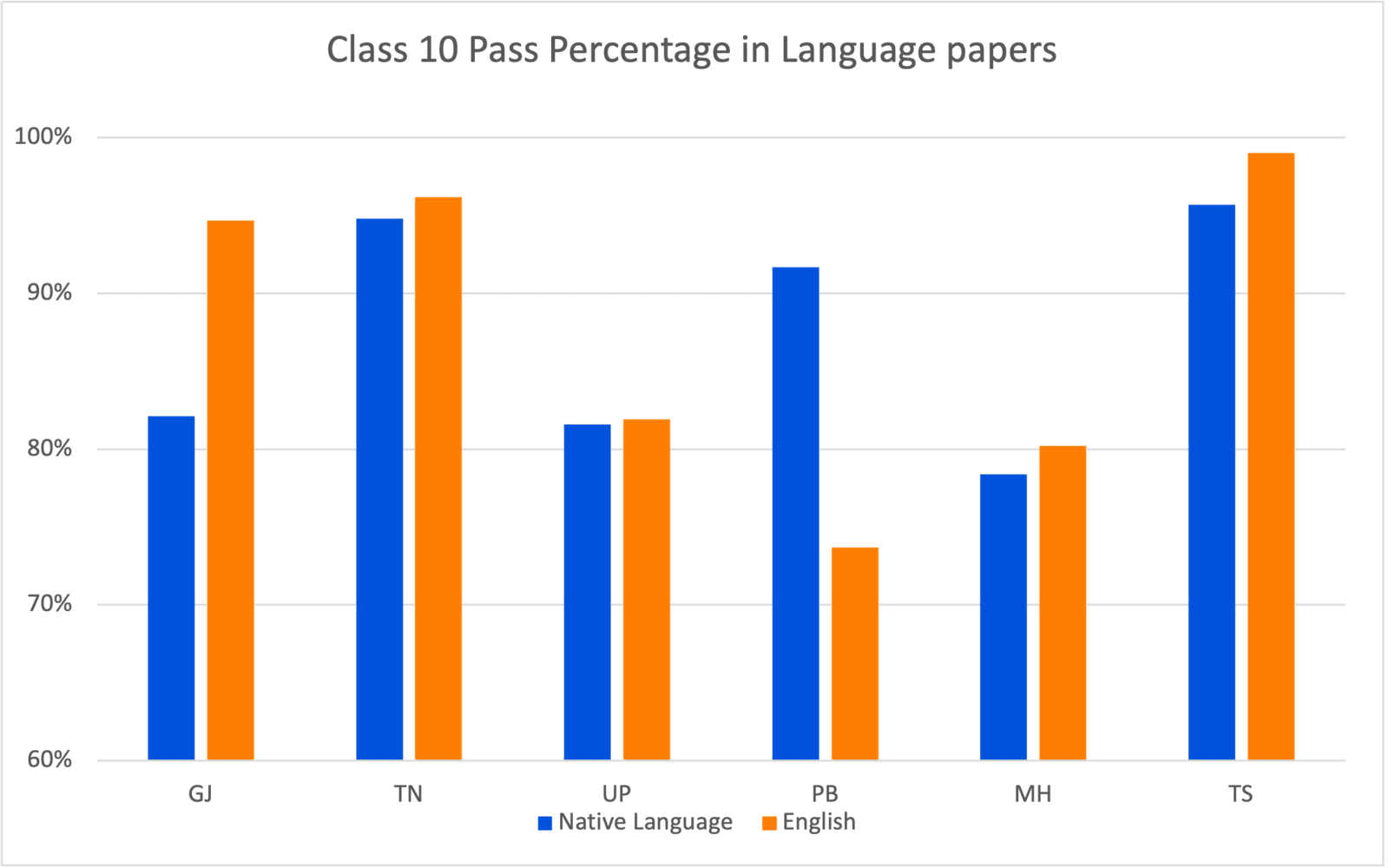Native language proficiency could become a crucial factor in the education and academic success of students in early education. Research by UNESCO [1] or academic organizations has shown that students proficient in their native language tend to perform better academically and have a stronger sense of cultural identity and belonging.
However, despite the importance of native language proficiency, students in Indian schools are facing significant challenges in maintaining/ improving their native language skills. For example, English has replaced the vernacular languages as the preferred medium of instruction in early education in the urban areas, thereby reducing the native language to merely a single subject. Concerningly, this is also spreading to rural areas albeit slowly. This has actually led to a situation, where the Indian students are significantly found lacking in their native language proficiency.
Here we explore the relationship between native language proficiency and student success, particularly in early education. We also analyze the current status of language proficiency in Indian schools.
Language proficiency and Learning Quality in Schools
Assuming that typical schools will have a mix students from different socio-cultural backgrounds, we can expect their language proficiency to fall within a spectrum with one extreme corresponding to good English proficiency and the other to native language proficiency (in some rare cases, we might have students that are equally proficient in both languages). With English becoming the de facto medium of instruction in classrooms across the country, a student not so proficient in English will face significantly higher odds compared to a student that is proficient in English. There are few ways in which the native language proficiency and the learning quality in schools are interlinked to each other.
Identity and Cultural connect: For many students, their native language represents a connection to their family, community, and cultural heritage. Therefore, using their native language in school can help students feel valued and connected to their cultural identity, enhancing their overall sense of belonging and emotional/ mental well-being in school.
Better Academic Success: Studies have shown that students who are proficient in their native language tend to perform better academically than students who are not proficient in their native language. This is because language proficiency is closely tied to cognitive skills such as reading comprehension, problem-solving, and critical thinking. Students proficient in their native language can better understand and engage with the material taught, leading to improved learning outcomes.
However, as noted earlier, the official language of instruction is usually English for practical purposes. Thus, a child who is not very proficient in English will find it difficult to understand, participate in the class when the medium of instruction is English. Further, children lacking in English will even find it hard to follow the learning materials written in a language that is foreign (English) to her/ him. This can result in academic disinterest/ lack of engagement for children leading to decreased learning ability.
All other things being equal, two children with different levels of English proficiency might end up in drastically different academic performance. This can lead to a lack of confidence and decreased learning ability for children that doesn't have good English proficiency in the beginning. The early education system might thus be inadvertently introducing inequality in the learning among groups of children, which will likely perpetuate in the intermediate and high schools as well.
Ability to learn new languages: Students proficient in their native language can easily learn a second language, whether it is English or some other language. However, when students have good English proficiency, they do not typically show interest in mastering their native language and they grow up with low to average proficiency in their language. This is probably because of the huge variety of recent, relevant content available in English in social media, kids magazines etc. compared to their native language. While this is a subjective view based on anecdotal experience, the evidence for this can clearly be seen across urban India. A detailed study will likely explain this better and also identify further reasons.
Communication and Social Interactions: Students who are proficient in their native language are able to communicate more clearly and accurately with their peers, teachers, and other community members, leading to improved social skills and a stronger sense of belonging within the school community. Students who are not proficient in the language of instruction may need help participating in class discussions and may feel isolated from their peers.
In addition to communication within the school community, native language proficiency also enables the students to interact with the wider society. This includes communication with vendors, service providers, and other individuals outside of their immediate network, such as friends, family, and teachers.
Without native language skills, children proficient only in English may be isolated from the common non-English speaking population in their lives and may not be able to understand, appreciate, or empathize with these individuals. By promoting native language proficiency in schools, educators can help students develop the skills they need to effectively communicate and interact with others in their community, fostering a sense of belonging and connection to the wider society.
English vs Vernacular Languages in Indian Schools
As we noted earlier, English is fast replacing the vernacular languages as the preferred medium of instruction in schools across India. The trend was only in vogue in urban areas two decades back but is spreading to rural areas across different states in the country. There are different factors for this preference such as i) English being perceived as a 'global' language, ii) parental expectations, iii) peer pressure, iv) general societal trend and v) job opportunities for English proficiency.
This trend is leading to the vernacular languages being pushed to a secondary status in early education in Indian schools. It should be noted that this trend is also seen in the intermediate and higher education scenario. English is even routinely mentioned as the first language in many Education boards, whereas by definition this tag should be reserved for the primary language of the respective states.
The vernacular language doesn't get its due importance even as a second language in many instances due to various reasons such as quality of the pedagogy, minimal hours for the subject and lacklustre attitude of schools/ teachers/ students/ parents towards the subject. For example, since the marks scored in a language subject is not used in the college/ university admission process, the subject is given just enough importance for the students to pass.
Current state of Native language proficiency in Indian schools
We first look into to the medium of instruction question across states. The idea is to see how the preference for English as the medium of instruction varies across the states. The below chart shows student enrollment statistics (Source: 2019-20 UDISE+ Data [2]) in schools by the medium of instruction in different states. As can be seen all the Southern states, except for Karnataka, has over 50% students enrolling in English-medium. The Telugu states are particularly notable in that in both over 70% of the students prefer English-medium over Telugu. Northern states like Haryana and Punjab also appear to be transitioning to English over the state's majority language. Jammu & Kashmir and West Bengal appears to be outlier states, where majority preferring English and Bangla medium schools respectively.

We now examine specifically the current state of native language proficiency vis-à-vis English in Indian schools. The data for this was not readily available and so we looked into the news reports (Academic years 2019-20 thro' 2021-22) for the Class 10 results in different states and compared the pass percentage in the language (English and native language) papers. It should be noted that this is not a direct indicator of the language proficiency. However, this clearly is a reliable indicator in measuring the efficacy of language learning in a formal learning setting over a 10 year period. In all states except Punjab, the pass percentage in the native language trails that of English to varying degree though. In some cases like Maharashtra, the pass percentage for English varied depending on whether it is thought as first or second or third language and we had chosen the first and second language to make the comparison fair.

In any case, this seem to suggest the native language to be lagging behind English in terms of the learning efficacy.
Despite the importance of native language proficiency for student success, there are challenges and barriers that can impact the ability of students in Indian schools to maintain and develop their language skills. One significant challenge is the lower pass rates for certain native languages compared to English.
In Ahmedabad, the mother tongue of Gujarati medium students, 1.19 lakh students failed the exam, with a passing rate of only 82.15%. This is in contrast to the 94.73% passing rate for English, which is considered the students' first language. Purshottam Magarvadiya, a Gujarati teacher for the last 33 years, commented that "The 82% passing rate in the mother tongue is not acceptable and is mainly because students prefer to ignore the subject, thinking they will be able to pass the examination. The focus is on Science and Mathematics and not languages" (Times of India, 2022). [7]
In UP, there have been lower pass rates for the Hindi subject compared to English over the past few years (UP Board, 2019-20). In 2020, more than 5.27 lakh high school students failed in the Hindi examination, while 5.19 lakh students did not pass in English (Hindustan Times, 2020). In 2019, more than 5.74 lakh students failed in Hindi paper of UP Board high school exam compared to 5.02 lakh students who failed in English. This trend of lower pass rates for Hindi compared to English has continued in recent years. This presents a significant challenge to native language proficiency in the region. There may be several reasons for these lower pass rates, including students spending more time studying science subjects and not prioritizing the study of Hindi, or taking their native language lightly (Hindustan Times, 2020). [5]
Conclusion
In conclusion, native language proficiency of our children in the present school education is certainly becoming a major concern across different states and this is rightfully worrying the educators and language experts. As we saw, there are a number of factors that can cause this and we need to take preventive measures to address the serious issues. The new National Education Policy (NEP) announced in 2020 certainly realizes the gravity of this issue and is rightly prescribing native language based education to address the same.
Further Readings
- UNESCO Report - https://unesdoc.unesco.org/ark:/48223/pf0000146632
- UDISE+ Publications - https://udiseplus.gov.in/#/page/publications
- UDISE+ Dashboard - https://dashboard.udiseplus.gov.in/#/home
- Why students are failing Hindi in its heartland?
- In UP Board, over 5.27 Lakh students fail in Hindi, 5.19 lakh students flunk in English
- More Students Fail In Mother Tongue
- Gujarati me fail, English me pass
- 2.6 lakh SSC students fail in Maharashtra's official language exam | Mumbai News
- Preference of English medium instruction rises in South India except Karnataka
- English becomes most preferred medium of instruction in all southern states except Karnataka: Study
- Telangana: Telugu tangle, not maths or science hurdle hit SSC students | Hyderabad News - Times of India
- PSEB 10th result: English records lowest pass percentage, 89,000 students fail
